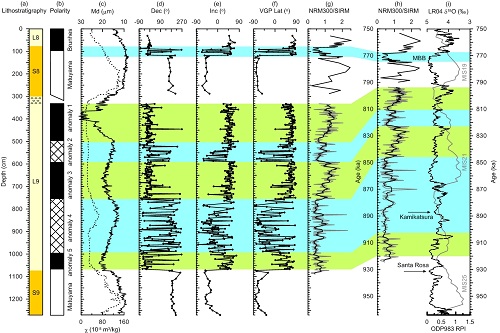Remagnetization mechanism and a new age model for L9 in Chinese loessUpdate time:11 03, 2011
Postdoctor JIN Chunsheng and his teacher LIU Qingsong systematically investigate magnetization mechanism of L9 unit at the classic Luochuan section. Using combined grain size and environmental magnetism parameters, an extended climatic optimum corresponding to marine oxygen stage (MIS) 21 can be identified in middle of L9. A remagnetization mechanism of viscous remanent magnetization overprinting on characteristic remanent magnetization (ChRM) carriers (mainly large pseudo single domain and multidomain magnetite particles), associated with the chaotic detrital remanent magnetization caused by low efficiency alignment of ChRM carriers along with the ambient field during deposition, is proposed to interpret the magnetic anomalies. This study provides new insights into the magnetization mechanism of the Chinese loess, and the new age model for L9 helps to accurately refine the finer scale correlation of paleoclimatic records between the Chinese loess and marine sediments.
Fig. 1. A schematic map of the distribution of the Chinese loess and the location of the Luochuan section. (Image by JIN)
Fig.2. (a) Pedostratigraphy; (b) magnetic polarity; (c) low-field susceptibility (dashed line) and Md curve (solid line); (d) declination (Dec) of the ChRM; (e) inclination (Inc) of the ChRM; (f) virtual geomagnetic pole latitude (VGP Lat); (g) NRM after 300 _C thermal demagnetization normalized by SIRM (NRM300/SIRM); (h) time-dependent NRM300/SIRM. The dark line is a 5 points running average; (i) relative paleointensity (RPI) data. (Image by JIN) Jin et al. Remagnetization mechanism and a new age model for L9 in Chinese loess. Physics of the Earth and Planetary Interiors.2011,187, 261-275(Download Here)
|
Contact
Related Articles
Reference
|
-
SIMSSecondary Ion Mass Spectrometer Laboratory
-
MC-ICPMSMultiple-collector ICPMS Laboratory
-
EM & TEMElectron Microprobe and Transmission Electron Microscope Laboratory
-
SISolid Isotope Laboratory
-
StIStable Isotope Laboratory
-
RMPARock-Mineral Preparation and Analysis
-
AAH40Ar/39Ar & (U-Th)/He Laboratory
-
EMLElectron Microscopy Laboratory
-
USCLUranium Series Chronology Laboratory
-
SASeismic Array Laboratory
-
SEELaboratory of Space Environment Exploration Laboratory
-
PGPaleomagnetism and Geochronology Laboratory
-
BioMNSFrance-China Bio-mineralization and Nano-structure Laboratory

 Print
Print Close
Close

